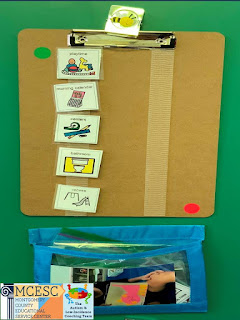Visual schedules can be an extremely effective support for students. They provide clear expectations and structure, reduce anxiety, and can help to facilitate transitions. However, at times a team may need to troubleshoot concerns that come up when implementing this tool to increase its effectiveness. Today's Super Star Schedules post will feature ideas we have seen in our districts for Troubleshooting Common Student Schedule Concerns.
Concern #1: The student doesn't pay attention to the schedule.
It is important that the student is interacting
with the schedule. If it is just posted
on the wall or lost in a desk, the student may not connect with it. Encourage the student to interact with the
schedule regularly by having them move each picture into a “finished” area or
put a check next to each event as it is completed.
 |
| VeraKaye Sowers Northridge Elementary, Northridge |
 |
| Dustin Krouse Horace Mann Elementary, Springfield |
 |
| Cynthia Resch Learning Center-West, MCESC |
 |
| Heidi Horner Miami County ESC |
 |
| Rachel Engle Horace Mann, Springfield |
Casey Morter
Mad River Preschool, Mad River
We have more examples of individual schedules in our previous posts:
Concern #2: The student struggles to transition.
If simply interacting with the schedule isn't enough, we often recommend implementing a location-based schedule where the student matches the card from their schedule to a visual in the corresponding location.
 |
| Rylie Jarrett Stevenson Elementary, Mad River |
 |
| Brittany Wendling Valley Elementary, Beavercreek |
For more examples of location-based schedules check out our previous posts.
Concern #3: There is a learning barrier.
If you have worked to teach the purpose of the schedule and the student still doesn't seem interested, there could be a learning barrier. For some students, the popular picture icons may not meet their individual needs. Some may need actual photographs, others may need the pictures blown up or may need to use objects.
 |
| Makayla Barber Mad River Preschool, Mad River |
 |
| Jamie Minnish Prass Elementary, Kettering |
For students who visual impairments, you may need to use high-contrast icons or incorporate tactile icons with braille.
 |
| Hayward Middle School, Springfield |
 |
| Carla Bryant Miamisburg |
Concern #4: Lack of Motivation
Incorporate special interests or student choice to get their buy-in and make the schedule more interesting for them. We have even had teams sit down with the student to choose their own icons to create their schedule.
 |
| Jackie Vollmer Driscoll Elementary, Centerville |
 |
| Maggie Brackman Northwood Elementary, Northmont |
Since a schedule provides security for the student, it is important that the student can access it at all times. Therefore, students who frequently transition outside of their main classroom may benefit from a portable schedule option.
 |
| Jolene Allen Brantwood Elementary, Mad River |
 |
| Lindsey Woods Fairborn Primary, Fairborn |
 |
| Tim Cundiff Greenville High School, Greenville |
 |
| Ashley Watson Madison Park Elementary, Trotwood |
 |
| Heather Clark Saville Elementary, Mad River |
 |
| Rose Jepson Northridge Elementary, Northridge |
 |
| Megan Logano Clark ESC |
 |
| Alicia Barnishin Cookson Elementary, Troy/Miami County ESC |
Concern #6: Each student in the classroom has a different schedule
Creating individual schedules for every student in the classroom can make transitions easier because it increases their independence and staff doesn't have to memorize everyone's schedule and provide verbal prompts. This helps when there are multiple grade-levels in one room, if students transition in and out of the classroom for inclusion, or you use centers in the classroom.
Concern #7: The student has mastered the schedule.
Even if you feel like the student knows the routine, a visual schedule is a tool that the student can fall back on during times of confusion, anxiety, or when there are changes. Rather than getting rid of this effective support, create an individual schedule that can grow with the student. Fade visual icons and provide schedules that can easily be tucked in a binder or folder. |
| Nichole Dunn Miamisburg Middle School, Miamisburg |
 |
| Vince Lintner Miamisburg High School, Miamisburg |
 |
| Cassandra Hebauf Northmoor Elementary, Northmont |
For more ideas on creating schedules for older students check out our previous posts
Written Schedules
Top 3 Tips for Creating Written Schedules for Older Students




























